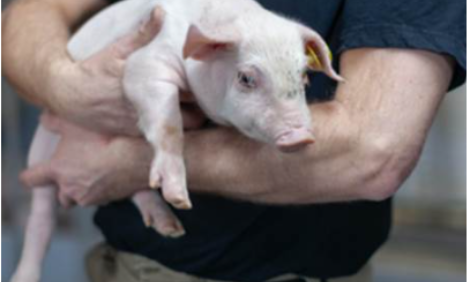



Efficiency of Energy Utilisation by Growing Pigs Selected for Potential Growth Rate
In the 2011 Annual Report from the Prairie Swine Centre, A.D. Beaulieu, J. Shea, D. Gillis and J. Marriott report that segregating pigs and feeding based on potential growth rate does not improve the ability to match feed to requirements.
Introduction
Despite years of breeding for specific characteristics, variation still
exists within our population of pigs with respect to growth, feed intake
and feed efficiency. This trial is part of a series of experiments
designed to improve our understanding of energy metabolism in
growing and finishing pigs.
The overall objective of this experiment
was to determine if early growth rate (potential growth rate, PGR)
is predictive of efficiency of energy utilisation later in life. Understanding
the differences in energy utilisation among fast and slow
growing pigs will help us to manage and develop cost-effective
feeding programs that most closely meet the specific requirements
of these groups of pigs.
Materials and Methods
* "Segregating pigs and feeding based on potential growth rate does not improve the ability to match feed to requirements" |
Sixty barrows were assigned to either a slow, average or fast PGR
group based on growth rate from birth to nursery exit. When the
pigs reached 30kg bodyweight, they were placed in individual pens and
assigned to receive either a low- or a high-energy diet at 100 or 85
per cent of ad libitum intake. The experiment therefore, had a total of 3×2×2 = 12 treatments, (three growth potentials, two dietary energy concentrations and two intake levels).
Diets are described in Table 1. The high-energy diet had more wheat and canola oil and less
barley than the low-energy diet. Diets were formulated with a
comparable standard ileal digestibility (SID) per cent lysine, therefore
the lysine/energy ratio was lower in the high energy diet. Lysine,
however, was formulated to be non-limiting in both rations. Diets
contained 0.4 per cent celite, a source of acid-insoluble ash used as a
marker for digestibility calculations.


The pigs were slaughtered when they reached 60kg bodyweight, the carcasses
ground and analyzed for nutrient content. Comparing the
data with a group of pigs slaughtered at the beginning of each experiment
allows the calculation of nutrient retention within each
growth period. Dietary NE was calculated as RE + FHP where RE =
energy retained in the carcass and FHP = fasting heat production
estimated as 179kcal per kg BW0.6 (Noblet et al., 2003).
Faeces were collected throughout the growing period to allow for
the measurement of DE and estimation of NE using the equations
developed by Noblet (2004) and the CVB (2005) which are predictive
equations based on nutrient content and digestibility.
Results
The pigs were selected for PGR based on growth rate in farrowing and nursery. The targeted body weight to begin the experiment was 30kg for all pigs, therefore pig age differed. The slow-growing pigs were about 98 days of age, almost four weeks older than the fastest growing pigs, who had reached 30kg bodyweight at only 71 days of age. The average PGR group was 78 days of age. Despite this, average daily gain from 30 to 60kg bodyweight was only slightly higher for the fast PGR pigs. A lower daily feed intake for these pigs resulted in a tendency for an improved feed efficiency (P=0.07; Table 2). Energy concentration of the diet had no effect on growth rate; feed intake was reduced on the high-energy diet, therefore feed efficiency (kg/kg) was improved for pigs fed this diet.

As expected, pigs fed the diet at 100 per cent had improved growth relative
to pigs allowed only 85 per cent of ad libitum. Feed efficiency (kg/kg)
was also improved at the higher feed intake.
The efficiency of utilisation of energy for growth, protein or lipid
deposition was numerically lower for the fast growing pigs than the average or slower growing pigs; however, this difference was
not significant (Table 3). The efficiency of energy utilisation for
protein or lipid deposition (g per Mcal intake) was improved with the
low-energy diet. Pigs fed the diet at 85 per cent ad libitum utilised energy
more efficiently than those allowed 100 per cent intake, regardless
of PGR or dietary energy concentration. The ad libitum fed pigs had
fewer days to reach 60kg, grew faster, ate more and had improved
feed efficiency. However, the efficiency of energy utilised for protein
or lipid deposition was improved with the lower intake.

The experimental DE and NE values obtained are
shown in Table 4. The DE content of the diets was much
lower than expected.
The authors do not have an explanation for
this. These diets were representative of others they have
used and energy digestibility was higher. The NE values
calculated using the INRA (French) equation were
similar to the formulated NE concentration. The values
used in our formulations are largely obtained from the
INRA data base so this is evidence that this database is
useful for feedstuffs obtained in Western Canada.

Conclusions
The efficiency of the utilisation of dietary energy for growth was comparable among pigs selected for high or low potential growth rate. This implies that segregating pigs and feeding based on PGR is not a tool that will improve our ability to match feed to requirements.
Acknowledgements
Strategic funding provided by Sask Pork, Manitoba
Pork Council and Saskatchewan Agriculture
and Food Development Fund. Funding
specifically for this project from the National
Sciences and Engineering Research Council of
Canada (NSERC) and Cargill is gratefully acknowledged.
September 2012








